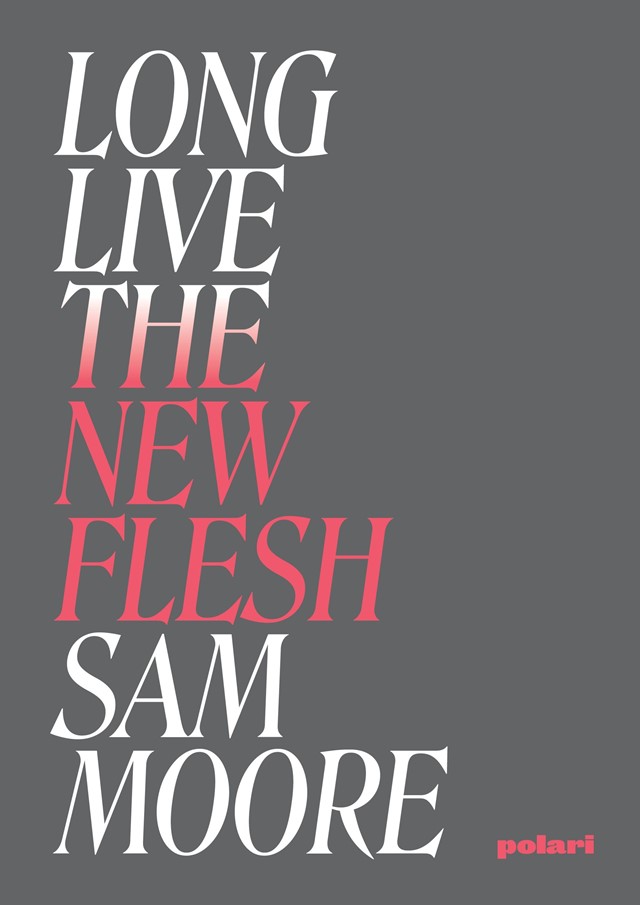As their new book is published by Polari Press, Sam Moore talks about reclaiming horror tropes that have historically been wielded against queer and trans folk
Horror films are so damn trans – just take the final scene of David Cronenberg’s Videodrome. A super glam 1980s Debbie Harry, wearing a bombshell red dress with blown-out auburn hair, speaks to our worn and disorientated male protagonist from a TV screen: “Your body has already done a lot of changing. But that’s only the beginning. The beginning of the new flesh. You have to go all the way now, a total transformation. Do you think you’re ready?” The television proceeds to violently explode into guts. Come on – this is trans dog-whistling in its campiest, most fabulous of forms.
With Videodrome’s final line as its title, Sam Moore’s new book, Long Live the New Flesh, explores the curious relationship between trans identity, the body and its presentation in mass media. Following their poetic longform essay All My Teachers Died of AIDS (Pilot Press, 2020), the prolific young critic weaves together everything from Buffalo Bill and Love Island, to Macbeth and late-night confessions to navigate their personal gender identity in the context of recent pop-cultural history. Touching, amusing and subtle, the collection works to reclaim horror tropes long wielded against queer and trans folk.
“Horror has always been near and dear to me”, they say while dressed in a black Nightmare on Elm Street long tee, “and I’ve recently been falling in love with reality TV – Drag Race and Love Island especially. I have a real soft spot for finding substance and meaning in the ‘low and trashy’. Body horror and reality TV are both great for that. They both ended up coming together in the book as an exploration of the performance of bodies and their presentation on camera.”
Here, Moore speaks about the performance of reality television, reclaiming problematic tropes, and the fluidity of poetry and transness.

Donna Marcus: How has bringing together body horror and reality TV been a useful way to explore gender identity?
Sam Moore: Both horror and reality TV are about the limits of how fluid a body can be when it’s presented. Drag Race – my reality TV tombstone in the book – is the perfect example. For a show about drag, you spend half of every episode with the contestants out of drag talking about their personal lives. After recent backlash, the show has consciously tried to expand how it defines gender and drag, and we’ve seen a real influx of trans contestants across the franchise over the last few years with people doing big tearful coming-out-as-trans bits.
Doing this all on TV, there’s a lot of layers of performance – drag as performance, reality TV as performance – which dovetails really interestingly with the performance of gender. It takes what you think of as a certain kind of body or a certain kind of gender identity and shows there are limits to it. It allows you to see that the relationship between the body, how it looks, and how you identify is very fluid. Similarly, there’s something about horror that challenges the ways in which you conceive of the line between a normative body and not. It makes narrative tropes of gender into violent, bloody, kicking, screaming texts. Films like Videodrome, Shivers and the Frankenstein films are all about the construction and deconstruction of bodies, so whilst they are not explicitly written as trans narratives, there’s a lot of room for trans interpretation.
DM: Lots has been written about monsters as being queer-coded in horror films. What drove you to continue to explore this in the book?
SM: The book pays a lot of attention to cultural history. Relative to queerness, it’s doubly important to pay heed to political cultural moments from the past. Canonical texts and our cultural past are always going to be intertwined with the contemporary, you can’t shake it off. This is why the reclamation of problematic tropes in the book is important. You can’t just ignore it, because it’s difficult. I’ve taken subjects that have historically been seen as monstrous, negative tropes, and have realised there’s actually space in here where I can find myself. There’s space for liberation in this.
One of my favourite poems in the book is about Buffalo Bill. You can’t do a book about transness and horror without talking about The Silence of the Lambs in one way or another. For more than three decades it’s been shorthand for what trans looks like in horror – a guy killing women and wearing their skin. Whilst wearing women’s skin and killing them is obviously terrible, there is something significant about that moment when Bill is looking in the mirror. To be able to look in the mirror and see yourself as an object of desire is, in my experience, not the most common feeling in the world. But that moment in The Silence of the Lambs, in its horrifically twisted way, is a moment of self-actualisation. That’s worth dwelling on and taking seriously, beyond it being just a moment of horror cliche.

DM: The book deals with personal complexities of desire and identity. Do you think there are particular difficulties to feeling desirability as a non-binary person?
SM: Unless you’ve openly stated your gender to someone, or you’re presenting in a certain way, there can be more of a gulf between how a person looks at you versus how you perceive yourself. You need to navigate how much to let another person in, and whether that will change their perception of you. So desirability becomes increasingly more to do with how someone else perceives me and my gender.
DM: You’re constantly writing about art and popular culture as a critic. What does poetry allow you to do that your criticism can’t?
SM: Poetry, in my experience of reading and writing it, allows space for an uncertainty that perhaps more traditional prose does not. Looking at how poetry is spaced – and this is my time at workshops coming through – there’s a tension between what is and isn’t on the page, in everything from word choice, to line breaks, to subtext versus text. Poetry allows for that space in between. Language is inherently fluid and the meaning of words changes with time. So exploring language, titles and what things mean in detail can open them up to non-binary, trans interpretation. A lack of complete sureness in your identity is good. You’re not finished, as it were. Above all, language reflects that.
DM: If this collection is about navigating your gender identity, do you feel you’ve arrived? If not, how long will this new flesh live for?
SM: As much as I have arrived in my transness, I don’t think that arrival is the end of becoming. This isn’t an endpoint. I don’t feel static or fixed and probably never will. I think that’s good.
Long Live the New Flesh is published by Polari Press and is out now.
